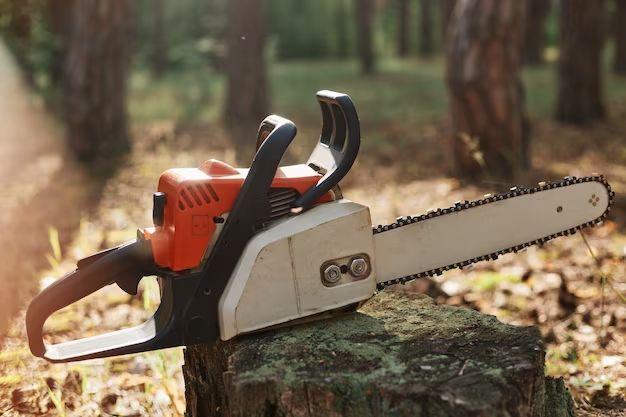Whether it is okay to store a chainsaw vertically is a common question for chainsaw owners. There are a few factors to consider when determining the best way to store a chainsaw.
Page Contents
Gas and Oil Leakage
One of the main concerns with vertical chainsaw storage is potential gas and oil leakage. Chainsaws contain a fuel mixture of gasoline and 2-stroke engine oil. This mixture is essential for lubricating the engine and powering the chainsaw. However, when stored vertically, there is a risk of the fuel and oil leaking out of the carburetor or fuel lines over time. This can create a fire hazard and damage the chainsaw engine and bar/chain. To prevent leaks, it is recommended to empty the fuel and run the carburetor dry before vertical storage. An alternative is to store the chainsaw horizontally to avoid unwanted drips and leaks.
Chain and Bar Damage
Storing a chainsaw vertically can also result in damage to the bar and chain over time due to gravity. When vertical, the weight of the bar/chain rests on the tip, which can cause the bar to slowly sag. This sagging effect overtime can bend or warp the bar. It also puts tension on the chain, which can cause the drive links to stretch and loosen. A loose chain needs to be tightened more frequently and can derail easier. For this reason, horizontal storage is best to avoid any long-term bar and chain damage.
Proper Functionality
Vertical storage may impact the functionality of a chainsaw over time. For example, storing a chainsaw upright can cause the fuel lines, carburetor, and crankcase to dry out. This is because the oil has tendency to drain downward away from these components. Dried out parts can lead to difficulty starting the chainsaw or cause the engine to seize up. Likewise, the muffler on a chainsaw is designed to vent fumes horizontally. Storing vertically can potentially cause backpressure and carbon buildup. For optimal performance and operation, manufacturers recommend horizontal storage.
Storage Space Constraints
In some cases, there may be storage space constraints that make vertical storage the only viable option. For example, if you need to save floor space in a shed or garage, hanging a chainsaw vertically on a wall can be an acceptable storage solution. Here are some tips for proper vertical storage:
- Use a sturdy chainsaw hanger or mount securely to the wall
- Ensure the chainsaw hangs balanced and will not tip over
- Remove bar/chain if storing long-term
- Allow engine to fully cool before storing to prevent oil drips
- Place a drip tray underneath to contain any leaks
Maintenance Requirements
Additional maintenance may be required if choosing to store a chainsaw vertically, such as:
| Maintenance Task | Required Frequency |
|---|---|
| Inspecting bar/chain for damage | Every 2-3 months |
| Checking fuel lines and carburetor for drips | Monthly |
| Cleaning muffler and engine of carbon buildup | Every 6 months |
| Lubricating engine and bar oil ports | Before each use |
Safety Considerations
Proper storage orientation also comes down to safety. Storing a chainsaw horizontally on a shelf or chained to a bench is generally safer than vertical wall storage. A chainsaw stored vertically has risks of damaging the wall, falling, or tipping over if bumped. Only mount vertically if there is adequate clearance space and strong, secure anchors. Keep out of reach of children and pets. A horizontal position is less prone to fall and cause injury.
Conclusion
In most cases, it is recommended to store a chainsaw horizontally to prevent fuel/oil leaks, bar and chain damage, dried out engine parts, and safety hazards. However, vertical storage on a secure hanger is acceptable for those with space constraints, provided steps are taken to remove fluids, inspect and maintain the chainsaw regularly, and mount safely. With extra care and maintenance, vertical storage can work. But horizontal is the optimal position for a chainsaw when possible.
